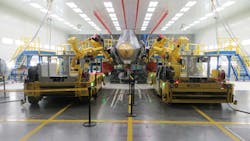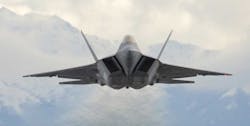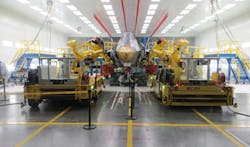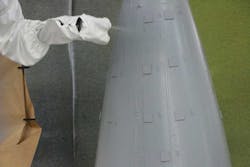Robots Keep F-22 Raptor Fighters Healthy and Stealthy
One of the U.S. Air Force’s most critical and time-consuming tasks is keeping its fleet of aircraft well maintained and operational. With some planes, such as the B-2 Bomber and F-22 Raptor, that includes keeping the radar-absorbent coating clean and smooth.
On the twin-engined F-22s, maintaining the coating, which helps maximize its stealthiness and survivability, is particularly difficult on the air inlet ducts. The inlets ensure smooth air flows into the engines despite turbulent air coming at the ducts from several directions. Small objects, possibly even hail, being sucked into the engine at high speed can likely put some scratches in the inlet’s surface finish.
To keep the plane performing at its best, the Air Force refurbishes the ducts periodically, sanding off the weathered coating and applying a new one. Since 2016, the Air Force has been using robots from Aerobotix to handle these chores.
Aerobotix received funding from the Air Force’s Small Business Innovation Research and Small Business Technology Transfer programs to develop its robotic painting system. On the F-22, it can restore the performance coatings on inlet ducts far more quickly, cost efficiently, and accurately than doing so by hand.
The automated painting system for the F-22s uses two robots working at the forward and aft ends of the ducts to sand and spray-coat them. Three of these systems have been installed at the F-22 Depot at the headquarters of the Ogden Air Logistics Complex at Hill Air Force Base, Utah.
“Our robotic technology can paint inlet ducts using only about 300 hours of labor, rather than the 1,600 hours it takes to do it manually,” says project manager Bret Benvenuti, a senior robotics engineer at Aerobotix. “That’s a labor saving of around 80%, so it really helps solve the challenge of getting these aircraft back into service quicker. And we estimate that since 2016, we’ve helped the Air Force save $8.8 million, $220,000 per aircraft, in maintenance costs.
The robots also improve accuracy and quality control, giving refurbished F-22s a lower radar signature.
“Recoating inlets manually requires that maintenance workers wear protective suits and respirators and spend hundreds of hours crawling around on their hands and knees inside of them,” says project lead Nathan Morgan, an Aerobotix field engineer. “Under those conditions, it’s nearly impossible for workers to manually apply the coatings at consistent speeds and thicknesses. The robots achieve better results while also curbing the amount of rework needed and number of worker injuries.”
The robots also save money on materials. For example, they spray on more coating before its pot life expires, significantly reducing waste. The highly engineered coatings cost around $1,000 per gallon, and more efficient use can save about $40,000 per aircraft, according to Aerobotix.
Aerobotix engineers recently added the ability to adjust the spray paths so the robots could more efficiently handle aircraft that need only the bypass screen areas of the inlets to be recoated or to spray only the exterior of the inlets’ forward outer lip. “Coating the lip while the aft robot is spraying the inlets saves two to three days in labor,” Benvenuti explains.
Aerobotix has also added a measurement device that uses Terahertz technology to measure the finished coating’s thickness. “It measures all the quality points much faster and more accurately than what has been done in the past,” he says.
The company is now looking to adapt the robots to simultaneously coat other exterior sections of the aircraft, including chines, which will create further labor savings.
Aerobotix refurbished its first F-22 in 2016, just finished work on its 40th and is on track to restore its 50th by early 2023. The company has also developed similar automated painting systems for coating F/A-18E and F/A-18F Super Hornets and F-35 Lightning IIs.



